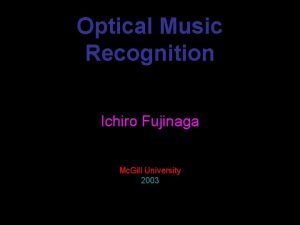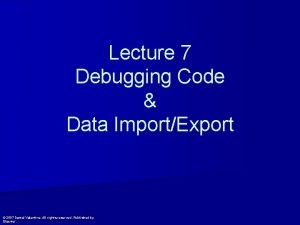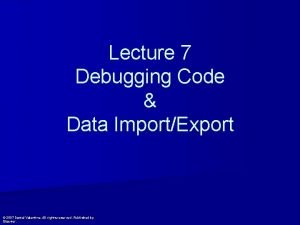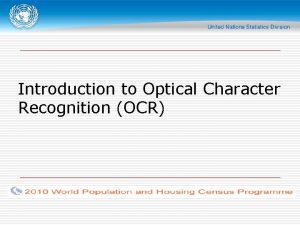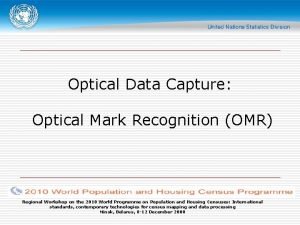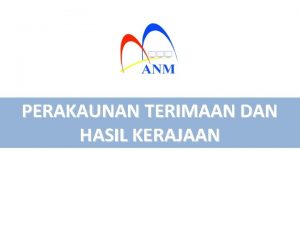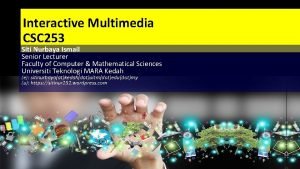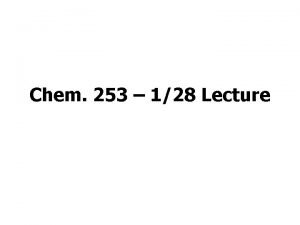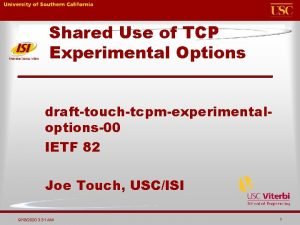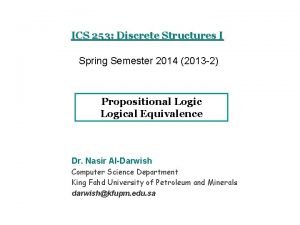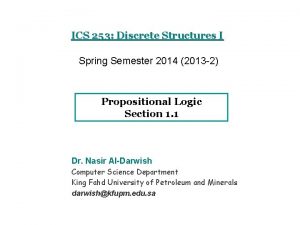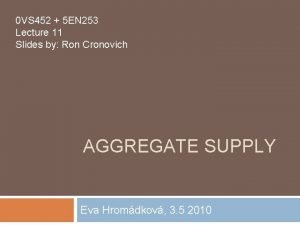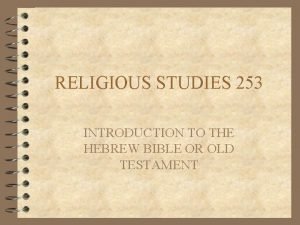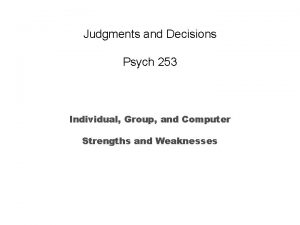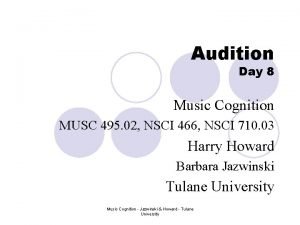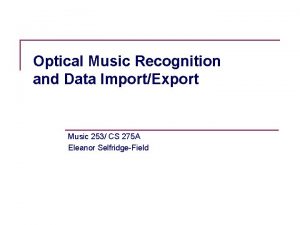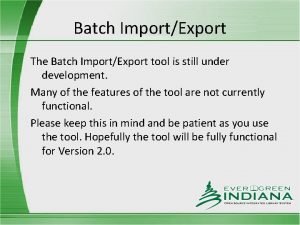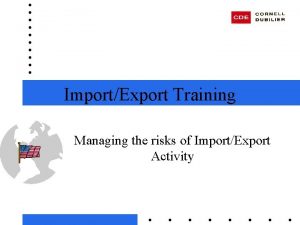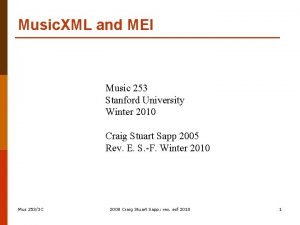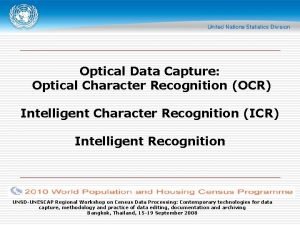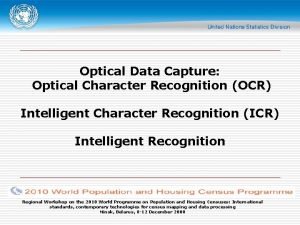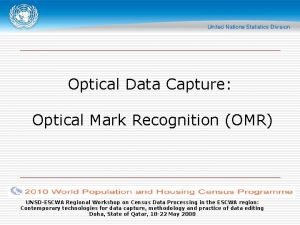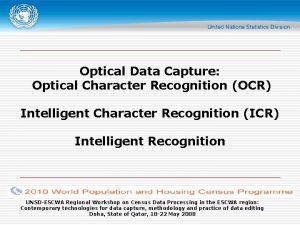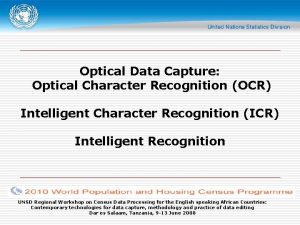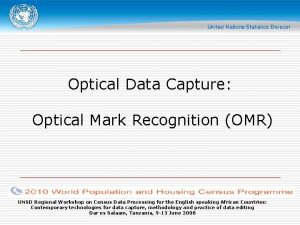Optical Music Recognition and Data ImportExport Music 253

















![Other OMR Software • Neuratron Photo. Score: http: //www. neuratron. com/photoscore. htm [Sibelius] • Other OMR Software • Neuratron Photo. Score: http: //www. neuratron. com/photoscore. htm [Sibelius] •](https://slidetodoc.com/presentation_image/03255f7f55247d207d95591756a2f600/image-18.jpg)

- Slides: 19

Optical Music Recognition and Data Import/Export Music 253/ CS 275 A Eleanor Selfridge-Field

Optical Music Recognition (OMR) History of efforts from c. 1968 • CCARH survey in 1993 -4: 37 projects, 7 responses Why is optical recognition difficult? • Semantic meaning of many objects depends on graphical context more than shape Sources and their legibility: • • Manuscripts: very irregular Out-of-copyright prints: images often deteriorated In-copyright prints: not legal to copy Errors in source Biggest problems for OMR developers • • Superimposition of objects in 2 D image Constraints imposed by output formats Mus 253/CS 275 A 2019 Eleanor Selfridge-Field 2

Basic problems in optical data acquisition • Image is crooked Mus 253/CS 275 A • Elements of layout unconventional 2019 Eleanor Selfridge-Field 3

How does OMR work? • Separation of lines and other Captured: matternotes, rests • Isolation of objects • Recognition of objects • Export to a format for • • storage printing sound data interchange Missed: slurs, pedal marks Mus 253/CS 275 A 2019 Eleanor Selfridge-Field 4

Why is OMR difficult? Problems of image quality: • Ideally • Staff lines are straight • Spacing is uniform • The scanned material is clean (unspotted) Slurs are symmetrical Beams are parallel All lines are unbroken • Problems of graphical context • • • Reality is different! • Symbols affecting interpretation of pitch • • • Symbols affect interpretation of duration • • Meter signatures Tempo indicators Fermatas Symbols relating to dynamics and technique • • • Mus 253/CS 275 A Key signatures Octave alterations 2019 Eleanor Selfridge-Field Dynamics marks Repetition of note-groups , of sections Instrumental technique 5

More difficulties Multiple configurations for same objects Methods of evaluation and control • Musical accuracy? • Handicaps for post-processing • Controls for input quality • Comparison of output formats • Weighing speed against accuracy and usability Haydn symphony n. 1 capture Fujinaga et al. Mus 253/CS 275 A Input Capture format Post. Processing Carter, scan 00: 20 SCORE 9: 20 CCARH, 2 -stage entry 2: 30 + 7: 05 Muse. Data 00: 15 2019 Eleanor Selfridge-Field 6

Samples from Library of Congress site Random material from loc. gov Mus 253/CS 275 A 2019 Eleanor Selfridge-Field 7

Close-up views of conventionally typeset music: Line recognition Surface imperfections Mus 253/CS 275 A Surface imperfections 2019 Eleanor Selfridge-Field 8

Close-up views (2): object recognition Missing contextual information Mus 253/CS 275 A Graphic imperfections 2019 Eleanor Selfridge-Field 9

Close-up views (3): 2 D ambiguities Dirt Mus 253/CS 275 A Variable appearance of equivalent objects 2019 Eleanor Selfridge-Field 10

Close-up views (4): ambiguities of placement Touching objects Mus 253/CS 275 A Unconventional presentations 2019 Eleanor Selfridge-Field 11

Sharp. Eye: File operations Comes from Shetland Islands Source code available Exports to Music. XML Four-step process • • Capture a page image View the auto-image Correct the image Save/export the result Vis-à-vis Muse. Data: • • Mus 253/CS 275 A 2019 Eleanor Selfridge-Field SE: score-based MD: part-based 12

Sharp. Eye: Raw Capture Mus 253/CS 275 A 2019 Eleanor Selfridge-Field 13

Sharp. Eye: Correcting the interpretation • Edit mode: • • Captured image below Interpreted image above Live object in red Available symbols in red Step 1: 1: Selectionaaportionthe scoretotoedit Mus 253/CS 275 A 2019 Eleanor Selfridge-Field 14

Sharp. Eye: Scrolling view Mus 253/CS 275 A 2019 Eleanor Selfridge-Field 15

Sharp. Eye: System edits Mus 253/CS 275 A 2019 Eleanor Selfridge-Field 16

Sharp. Eye: Data-interchange options Mus 253/CS 275 A 2019 Eleanor Selfridge-Field 17
![Other OMR Software Neuratron Photo Score http www neuratron comphotoscore htm Sibelius Other OMR Software • Neuratron Photo. Score: http: //www. neuratron. com/photoscore. htm [Sibelius] •](https://slidetodoc.com/presentation_image/03255f7f55247d207d95591756a2f600/image-18.jpg)
Other OMR Software • Neuratron Photo. Score: http: //www. neuratron. com/photoscore. htm [Sibelius] • Smart. Score: http: //www. musitek. com/ Capella. Scan Photo. Score Smart. Score Mus 253/CS 275 A 2019 Eleanor Selfridge-Field 18

Important questions about OMR software • What does “accuracy” mean? • Text recognition optimal error rate: 40/2000 chars • What output formats are available? • MIDI-level features only? • Graphical position? • Markup? • What kinds of errors? • Global variables? • Local events? • Non-MIDI objects Mus 253/CS 275 A 2016 Eleanor. Selfridge-Field 2019 20 19
 Optical music recognition python
Optical music recognition python Importexport 2007
Importexport 2007 Importexport 2007
Importexport 2007 Ocr full form
Ocr full form Definition of omr
Definition of omr Music music music
Music music music National archives gb rail 253/516
National archives gb rail 253/516 Arahan perbendaharaan penurunan kuasa
Arahan perbendaharaan penurunan kuasa Csc 253
Csc 253 Chem 253
Chem 253 Linear and nonlinear multimedia
Linear and nonlinear multimedia Kibd-253
Kibd-253 Ics 253
Ics 253 Ics 253
Ics 253 En 253
En 253 253 meaning in the bible
253 meaning in the bible Dlpp-261
Dlpp-261 Educational diagnostician practice exam
Educational diagnostician practice exam Psych 253
Psych 253 Music recognition
Music recognition
